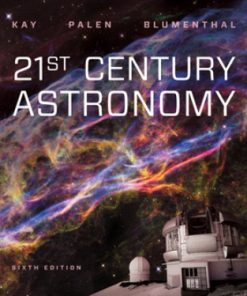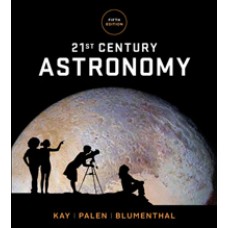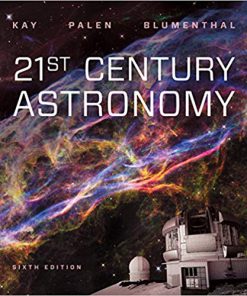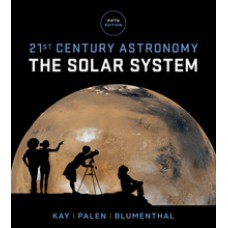Test Bank for 21st Century Astronomy Stars and Galaxies, Fifth Edition
$35.00 Original price was: $35.00.$26.50Current price is: $26.50.
Test Bank for 21st Century Astronomy Stars and Galaxies, Fifth Edition
Instant download Test Bank for 21st Century Astronomy Stars and Galaxies, Fifth Edition pdf docx epub after payment.
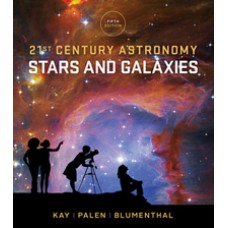
Product details:
- ISBN-10 : 9780393265125
- ISBN-13 : 978-0393265125
- Author: Laura Kay; Stacy Palen; George Blumenthal
Influenced by astronomy education research, 21st Century Astronomy offers a complete pedagogical and media package that facilitates learning by doing, while the new one-column design makes the Fifth Edition the most accessible introductory text available today.
Table of contents:
- Chapter 1: Thinking Like an Astronomer
- 1.1 Earth Occupies a Small Place in the Universe
- 1.2 Science Is a Way of Viewing the Universe
- 1.3 Astronomers Use Mathematics to Find Patterns
- Origins: An Introduction
- Summary
- Exploration: The Scale of the Universe
- Chapter 2: Patterns in the Sky—Motions of Earth and the Moon
- 2.1 Earth Spins on Its Axis
- 2.2 Revolution about the Sun Leads to Changes during the Year
- 2.3 The Moon’s Appearance Changes as It Orbits Earth
- 2.4 Calendars Are Based on the Day, Month, and Year
- 2.5 Eclipses Result from the Alignment of Earth, the Moon, and the Sun
- Origins: The Obliquity of Earth
- Summary
- Exploration: Phases of the Moon
- Chapter 3: Motion of Astronomical Bodies
- 3.1 The Motions of Planets in the Sky
- 3.2 Kepler’s Laws Describe Planetary Motion
- 3.3 Galileo’s Observations Supported the Heliocentric Model
- 3.4 Newton’s Three Laws Help Explain How Celestial Bodies Move
- Origins: Planets and Orbits
- Summary
- Exploration: Kepler’s Laws
- Chapter 4: Gravity
- 4.1 Gravity Is an Attractive Force between Objects
- 4.2 An Orbit Is One Body “Falling Around” Another
- 4.3 Tidal Forces Are Caused by Gravity
- 4.4 Tidal Forces Affect Solid Bodies
- Origins: Tidal Forces and Life
- Summary
- Exploration: Newton’s Laws
- Chapter 5: Light
- 5.1 Light Brings Us the News of the Universe
- 5.2 The Quantum View of Matter Explains Spectral Lines
- 5.3 The Doppler Shift Indicates Motion Toward or Away from Us
- 5.4 Temperature Affects the Spectrum of Light That an Object Emits
- 5.5 The Brightness of Light Depends on the Luminosity and Distance of the Source
- Origins: Temperatures of Planets
- Summary
- Exploration: Light as a Wave
- Chapter 6: The Tools of the Astronomer
- 6.1 The Optical Telescope Revolutionized Astronomy
- 6.2 Optical Detectors and Instruments Used with Telescopes
- 6.3 Astronomers Observe in Wavelengths Beyond the Visible
- 6.4 Planetary Spacecraft Explore the Solar System
- 6.5 Other Tools Contribute to the Study of the Universe
- Origins: Microwave Telescopes Detect Radiation from the Big Bang
- Summary
- Exploration: Geometric Optics and Lenses
- Chapter 7: The Formation of Planetary Systems
- 7.1 Planetary Systems Form around a Star
- 7.2 The Solar System Began with a Disk
- 7.3 The Inner Disk and Outer Disk Formed at Different Temperatures
- 7.4 The Formation of Our Solar System
- 7.5 Planetary Systems Are Common
- Origins: The Search for Earth-Sized Planets
- Summary
- Exploration: Exploring Exoplanets
- Chapter 8: The Terrestrial Planets and Earth’s Moon
- 8.1 Impacts Help Shape the Evolution of the Planets
- 8.2 Radiometric Dating Tells Us the Age of the Moon and the Solar System
- 8.3 The Surface of a Terrestrial Planet Is Affected by Processes in the Interior
- 8.4 Planetary Surfaces Evolve through Tectonism
- 8.5 Volcanism Signifies a Geologically Active Planet
- 8.6 The Geological Evidence for Water
- Origins: The Death of the Dinosaurs
- Summary
- Exploration: Exponential Behavior
- Chapter 9: Atmospheres of the Terrestrial Planets
- 9.1 Atmospheres Change over Time
- 9.2 Secondary Atmospheres Evolve
- 9.3 Earth’s Atmosphere Has Detailed Structure
- 9.4 The Atmospheres of Venus and Mars Differ from Earth’s
- 9.5 Greenhouse Gases Affect Global Climates
- Origins: Our Special Planet
- Summary
- Exploration: Climate Change
- Chapter 10: Worlds of Gas and Liquid—The Giant Planets
- 10.1 The Giant Planets Are Large, Cold, and Massive
- 10.2 The Giant Planets Have Clouds and Weather
- 10.3 The Interiors of the Giant Planets Are Hot and Dense
- 10.4 The Giant Planets Are Magnetic Powerhouses
- 10.5 The Planets of Our Solar System Might Not Be Typical
- Origins: Giant Planet Migration and the Inner Solar System
- Summary
- Exploration: Estimating Rotation Periods of the Giant Planets
- Chapter 11: Planetary Moons and Rings
- 11.1 Many Solar System Planets Have Moons
- 11.2 Some Moons Have Geological Activity and Water
- 11.3 Rings Surround the Giant Planets
- 11.4 Ring Systems Have a Complex Structure
- Origins: Extreme Environments
- Summary
- Exploration: Measuring Features on Io
- Chapter 12: Dwarf Planets and Small Solar System Bodies
- 12.1 Dwarf Planets May Outnumber Planets
- 12.2 Asteroids Are Pieces of the Past
- 12.3 Comets Are Clumps of Ice
- 12.4 Meteorites Are Remnants of the Early Solar System
- 12.5 Comet and Asteroid Collisions Still Happen Today
- Origins: Comets, Asteroids, Meteoroids, and Life
- Summary
- Exploration: Asteroid Discovery
- Chapter 13: Taking the Measure of Stars
- 13.1 Astronomers Measure the Distance, Brightness, and Luminosity of Stars
- 13.2 Astronomers Can Determine the Temperature, Size, and Composition of Stars
- 13.3 Measuring the Masses of Stars in Binary Systems
- 13.4 The Hertzsprung-Russell Diagram Is the Key to Understanding Stars
- Origins: Habitable Zones
- Summary
- Exploration: H-R Diagram
- Chapter 14: Our Star — The Sun
- 14.1 The Sun Is Powered by Nuclear Fusion
- 14.2 Energy Is Transferred from the Interior of the Sun
- 14.3 The Atmosphere of the Sun
- 14.4 The Atmosphere of the Sun Is Very Active
- Origins: The Solar Wind and Life
- Summary
- Exploration: The Proton-Proton Chain
- Chapter 15: The Interstellar Medium and Star Formation
- 15.1 The Interstellar Medium Fills the Space between the Stars
- 15.2 Stars Form in Molecular Clouds
- 15.3 Formation and Evolution of Protostars
- 15.4 Evolution before the Main Sequence
- Origins: Star Formation, Planets, and Life
- Summary
- Exploration: The Stellar Thermostat
- Chapter 16: Evolution of Low-Mass Stars
- 16.1 The Life of a Main-Sequence Star Depends on Its Mass
- 16.2 The Star Leaves the Main Sequence
- 16.3 Helium Fuses in the Degenerate Core
- 16.4 Dying Stars Shed Their Outer Layers
- 16.5 Binary Star Evolution
- Origins: Stellar Lifetimes and Biological Evolution
- Summary
- Exploration: Evolution of Low-Mass Stars
- Chapter 17: Evolution of High-Mass Stars
- 17.1 High-Mass Stars Follow Their Own Path
- 17.2 High-Mass Stars Go Out with a Bang
- 17.3 The Spectacle and Legacy of Supernovae
- 17.4 Star Clusters Are Snapshots of Stellar Evolution
- Origins: Seeding the Universe with New Chemical Elements
- Summary
- Exploration: The CNO Cycle
- Chapter 18: Relativity and Black Holes
- 18.1 Relative Motion Affects Measured Velocities
- 18.2 Special Relativity Explains How Time and Space Are Related
- 18.3 Gravity Is a Distortion of Spacetime
- 18.4 Black Holes
- Origins: Gamma-Ray Bursts
- Summary
- Exploration: Black Holes
- Chapter 19: Galaxies
- 19.1 Galaxies Come in Different Shapes and Sizes
- 19.2 Astronomers Use Several Methods to Find Distances to Galaxies
- 19.3 Galaxies Are Mostly Dark Matter
- 19.4 Most Galaxies Have a Supermassive Black Hole at the Center
- Origins: Habitability in Galaxies
- Summary
- Exploration: Galaxy Classification
- Chapter 20: The Milky Way—A Normal Spiral Galaxy
- 20.1 Astronomers Have Measured the Size and Structure of the Milky Way
- 20.2 The Components of the Milky Way Reveal Its Evolution
- 20.3 Most of the Milky Way Is Unseen
- 20.4 The History and Future of the Milky Way
- Origins: The Galactic Habitable Zone
- Summary
- Exploration: The Center of the Milky Way
People also search:
|
what are stars and galaxies
|
how were stars and galaxies formed
stars and galaxies answer key
|
types of stars astronomy
|
famous star astronomy
You may also like…
Test Bank
Test Bank for 21st Century Astronomy, 6th Edition, Laura Kay, Stacy Palen George Blumenthal
Test Bank
Test Bank for Operations and Supply Chain Management for the 21st Century 1st Edition by Boyer
Solution Manual
Solution Manual for Managers and the Legal Environment Strategies for the 21st Century, 8th Edition
Test Bank
Test Bank for Managers and the Legal Environment Strategies for the 21st Century, 8th Edition




